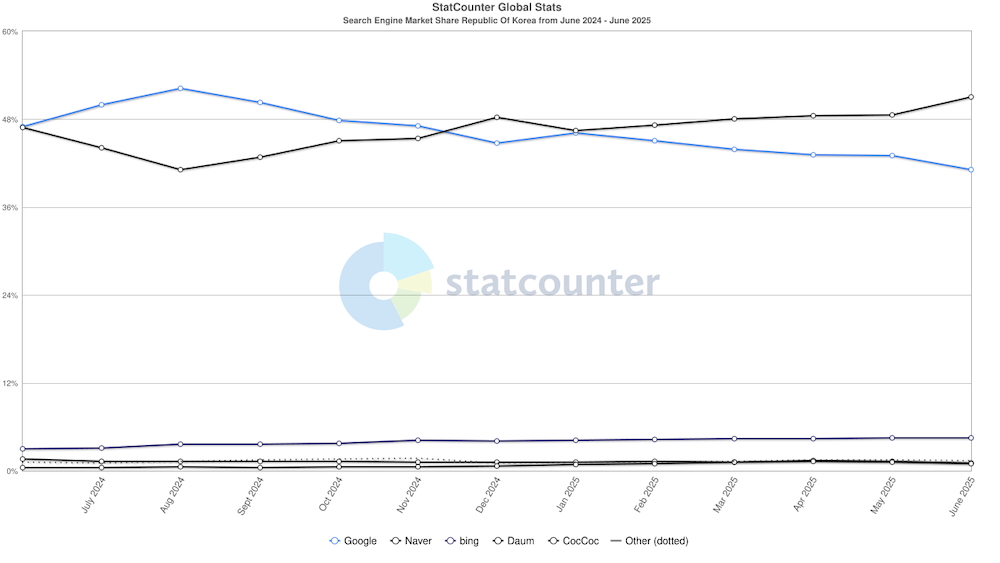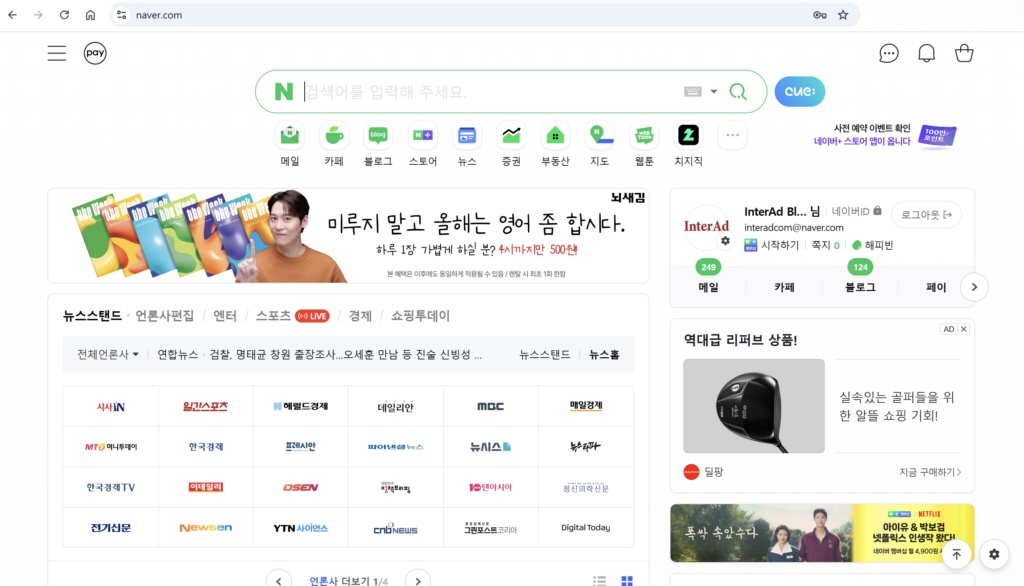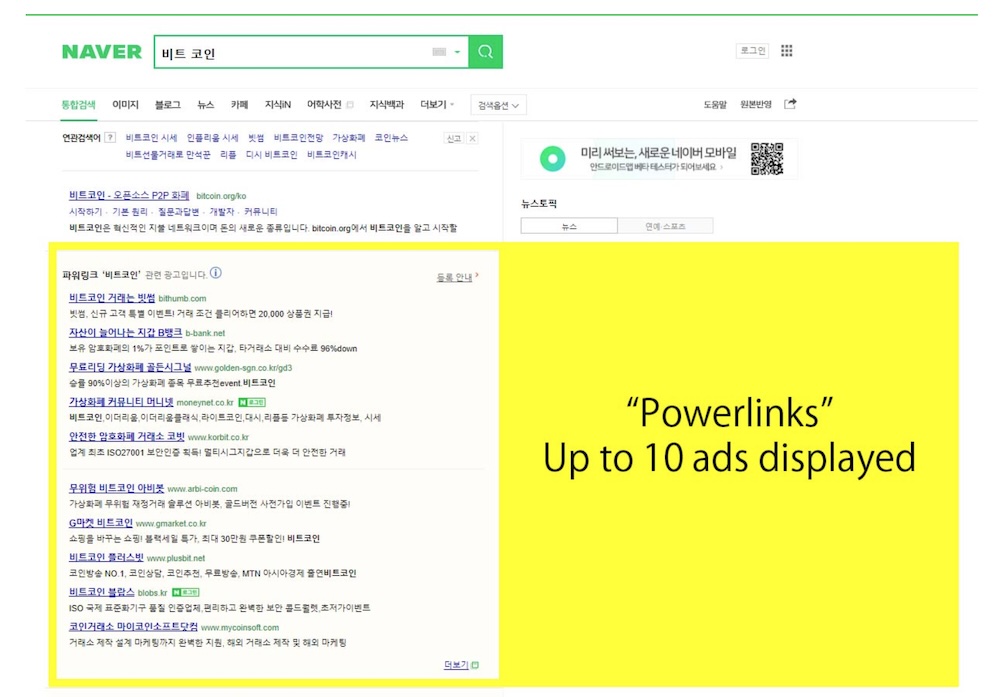Google has dominated much of the global search market, including the APAC region. However, in countries like South Korea, Google takes a backseat to homemade options. In this particular case, it’s the Naver search engine that maintains control of the Korean search market.
In This Article
Today, we’ll examine why, and how you can leverage Naver in Korea to maximize your SEM campaign.
As a Western company, you’re likely more familiar with Google’s interface and what it offers, and you assume that Naver is largely the same, just in a different language. But there’s so much more to Naver than most non-Korean brands realize.
That’s why, despite Google briefly overtaking the #1 spot in Korea in 2021-2022, Naver regained its control over the market in late 2024 with a margin that’s still widening today. There’s a familiarity among local users that Naver can appeal to much more effectively as a search engine. And that familiarity is because Naver doesn’t feel like a search engine at all, in the traditional sense.

Local vs Global Search Philosophy
Naver has its own eco-system, similar to how Yahoo is positioned in Japan. Naver offers blogging, forums and shopping, among other services within its own portal-style interface. This convenience means users rarely have to leave the “Naver bubble” to meet their needs.
User intent on Google, on the other hand, is more globally-minded. The search engine prioritizes official websites and global content in SERPs, which can be useful. However, a majority of Korean netizens prefer community-generated content over corporate websites and messaging. This is why Google struggled to find stability in Korea, although it did take the lead for a moment.
Why the Sudden Flip Back to Naver?
Google led the early charge as far as incorporating AI tools and assistants into its service. This was a major selling point for appealing to Gen Z, pulling many younger Korean web users away from Naver.
The latter quickly adopted, however. Naver’s inclusion of tools like HyperCLOVA X and SearchGPT satisfied a need that users were missing, and helped reassert its dominance.

Had Google maintained its momentum, developing an SEM/SEO strategy would be a bit more straightforward. Unfortunately, you’re gonna have to work a little harder to achieve success. With Naver, you’ll find SEM more nuanced, and SEO (at least the way we typically envision it) nearly non-existent.
Naver search engine marketing requires an entirely different approach than how you’d strategize for traditional search platforms. The first thing you should know is that Naver is very much a “Naver-first” platform. It prioritizes its own ecosystem, and does not index the web the way Google does. As such, thinking in terms of “rank” won’t get you very far in Korea.
We recommended putting forth effort into making your presence felt within Naver’s properties. We’ll relate these platforms in Western terms for familiarity:
Naver Blog
This is a long-form content format that allows you to tell your brand story. Its Western counterpart would be Medium or WordPress. It boasts social-features for shareability and visibility within Naver, and sees heavy usage by brands and influencers. Be sure not to skimp on visuals when posting.
Naver Café
Korean shoppers rely heavily on word-of-mouth, and this community-based, interest-group platform is where they go to inform their buying decisions. Its closest comparison would be Reddit or Facebook Groups.
Naver Shopping
For B2C brands, Naver Shopping could alleviate SEO headaches. Instead of trying to drive traffic to your own eCommerce website, focus on converting customers within Naver. The Shopping hub is reminiscent of Amazon, with added price comparison (think Google Shopping) and review aggregation features.

When Korean online shoppers are at the conversion point of the funnel, they do their final research and complete their purchases directly in Naver Shopping. Do your best to stand out.
Naver Knowledge iN
Naver Knowledge iN mirrors Quora in its Q&A format. Used primarily for recommendations and troubleshooting, users may also ping others here to gain deeper knowledge of your brands products or services. You can easily monitor posts and respond to relevant discussions as a subject authority or brand official.
While optimizing your organic efforts will help increase your presence on Naver, running Naver Ads is also helpful to supplement your strategy. Naver Ads comes in a variety of formats.

- Powerlink – Keyword-triggered text ads that appear at the top of Naver SERPs. Similar to Google search ads. Just as a warning, CPC can get a bit pricey for certain industries.
- Naver GFA – Visual ads that display throughout Naver-owned properties, such as blogs, news, café, etc. Its equivalent is Google Display Network ads, and you can similarly target based on interest, demographics and more.
- Shopping Ads – Shopping ads appear within product comparison tables, and occasionally within search results. This is great way to “stand out” as you get your foot in the door in the Korean market. The platform rewards ads with better placements for optimized product images and user reviews. We strongly recommend performing post-sale outreach.
Proper localization is the crucial factor to campaign effectiveness. Our ICJ team features native Korean staff with personal experience and certified expertise in all things Naver. We’ve helped clients from all over maximize their success in the South Korea market through Naver search marketing.
